


SITE LOGIN
-
REVIEWS
- Ski Gear
- Clothing
- Accessories
- Off-Season Gear
- Lifestyle
- Lodges and Accommodation
- Nutrition
- Manufacturers
- Destinations
- Training
- Gear of the Year
- Best New Summer Gear
-
Holiday Gift Guide
-
Holiday Gift Guide 2024
- Holiday Gift Guide 2024 Base Layers
- MSR Explore Revo Snowshoes
- Fieldsheer Backcountry Heated Jacket
- Fieldsheer Premium 2.0 Merino Heated Socks
- MEC Hut Booties and Slippers
- Arc’teryx Kopec GTX Shoe
- Arc’teryx Kragg Insulated Approach Shoes
- Gregory Verte 18 Backpack
- Grundens Deck-Boss Ankle Boot
- MEC Northern Light Vest
- Montec-Scope-Ski-Goggles
- Mountain Hardware Kor Airshell Hoody
- Mountain Hardware Kor Alloy Crew
- Arcade Atlas Belt
- Dynafit Ridge Dynastretch Jacket
- Shokz OpenRun Pro 2 headphones
- Buff Merino Move Multifunctional Neckwear
- Bootdoc Foot Warmer
- Cotopaxi Allpa 42L Travel Pack
- DPS LastBag
- DPS PHANTOM Glide At-Home Kit
- DPS Mission Quiver Roller
- Dragon Amped sunglasses
- Dragon DX3 Plus OTG photochromic goggle
- Fuse Lenses Anclote Flashback
- Garmin Fenix 8 Solar Sapphire Watch
- Gregory Alpaca Gear Tote 30
- Hotronic Boot Dryer
- MEC Aluminum Pot Set
- Gnara Go There Pants
- Grundens Shackleton 2.0 Duffel
- Jones Deeper 19L Backpack
- Le Bent Core Midweight Crew base layer
- Leatherman ARC
- Montane Nordes Hooded Softshell Jacket and Pants
- Helly Hansen Odin Everdown Hooded Jacket
- Helly Hansen Verglas Infinity Shell Jacket 2.0
- Montec Fawk Ski Jacket
- Pomoca Free Pro 2.0 Skins
- Rab Glaceon Pro Down Jacket
- Rab Khroma Converge GORE-TEX Ski Jacket & Pants
- Smith Squad MAG Goggles
- Stellar Guide Aerogel Hybrid Hood 2.0
- Stellar Ultralight Down Hood 2.0
- Arms of Andes Alpaca Half Zip & Wool Leggings
- Cotopaxi Allpa 70L Duffel Bag
- Giro Taggert Mips Helmet
- Loonr Hi Flyer Boots
- Paka Mountain Crew
- Roll Recovery SUPERPLUSH Classic Shoes
- Smartwool Smartloft Hooded Jacket and Pants
- Ortovox Switchback 32 Ski Touring Backpack
- Cotopaxi Allpa X 3L Hip Pack
- Giro Sagen Ski Goggle
- Icebreaker Ski+ Over the Calf Socks
- MEC-Fireside-Fleece-Snap-Pullover
- Montec Roast Mittens
- Mountain-Hardware-Sunblocker-Hoody
- MSR Titan Kettle 900 ml
- Tailgate-Industries-The Gondom-Goggle-Cover
- Wild Country Rope Tarp
- Bootdoc Race Merino PFI 50 Socks
- Remind Soles Destin Impact Insoles
- Kari Traa Rose Baselayer Half Zip Top and Pants
- Le Bent Midweight Quarter Zip
- Ombraz Dolomite Sunglasses
- Ortovox Fleece Rib Hoody
- Ortovox Merino Thermovent Base Layer
- Smartwool Intraknit Merino Tech Half Zip
- Suunto Wing Bone Conduction headphones
- Sweet Protection Adapter Mips Helmet
- Sweet Protection Connor Rig Reflect Goggles
- Zeal Optics Selkirk Glacier Glasses
- Norrona more flex1 Pants
- Norrona Octa Zip Hood
- Norrona Lyngen Alpha100 Zip Hood
- MEC Deluxe Pillow
- Holiday Gift Guide 2023
- Holiday Gift Guide 2022
- Holiday Gift Guide 2021
- Holiday Gift Guide 2020
- Holiday Gift Guide 2019
- Holiday Gift Guide 2018
- Holiday Gift Guide 2017
- Holiday Gift Guide 2016
-
Holiday Gift Guide 2024
- Pro Skier Interviews
- NEWS
- STORE
- ROUTES
- LODGING
-
VIDEOS
- 2022/23 Gear Reviews
- 2021/22 Gear Reviews
- 2020/21 Gear Reviews
- 2019/20 Gear Reviews
- 2018/19 Gear Reviews
- 2017/18 Gear Reviews
- 2016/17 Gear Reviews
- 2015/16 Gear Reviews
- 2014/15 Gear Reviews
- 2013/14 Gear Reviews
- 2012/13 Gear Reviews
- 2011/12 Gear Reviews
- 2020 Outdoor Retailer
- 2019 Outdoor Retailer
- 2018 Outdoor Retailer
- 2017 Outdoor Presscamp
- 2017 Outdoor Retailer
- 2016 Outdoor Presscamp
- 2016 Outdoor Retailer
- 2015 SIA Show
- 2014 Outdoor Retailer
- 2013 SIA Show
- 2012 Outdoor Retailer
- Tips and Tricks
- Backcountry Skiing
- SAFETY
- ABOUT
- REVIEWS
- NEWS
- STORE
- ROUTES
- LODGING
-
VIDEOS
- 2022/23 Gear Reviews
- 2021/22 Gear Reviews
- 2020/21 Gear Reviews
- 2019/20 Gear Reviews
- 2018/19 Gear Reviews
- 2017/18 Gear Reviews
- 2016/17 Gear Reviews
- 2015/16 Gear Reviews
- 2014/15 Gear Reviews
- 2013/14 Gear Reviews
- 2012/13 Gear Reviews
- 2011/12 Gear Reviews
- 2020 Outdoor Retailer
- 2019 Outdoor Retailer
- 2018 Outdoor Retailer
- 2017 Outdoor Presscamp
- 2017 Outdoor Retailer
- 2016 Outdoor Presscamp
- 2016 Outdoor Retailer
- 2015 SIA Show
- 2014 Outdoor Retailer
- 2013 SIA Show
- 2012 Outdoor Retailer
- Tips and Tricks
- Backcountry Skiing
- SAFETY
- ABOUT
TOP VIDEOS
Backcountry Access Float 36 Airbag Pack
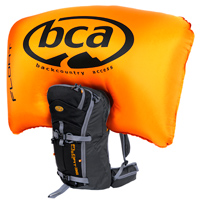 Back Country Access has been a pioneer in the airbag backpack market, currently offering three models in their Float series. Over the winter of 2012, Backcountryskiingcanada.com had the opportunity to try all three models: the Float 18, Float 30 and Float 36 - choosing the Float 36 for a long-term review. Additional weight withstanding, the Float series provides practical, convenient pack options for most backcountry enthusiasts, be it mechanized access or daylong touring. And of course there’s the airbag thingy, which is widely regarded as a valuable life saving tool in the event you are caught in an avalanche. More on this later…
Back Country Access has been a pioneer in the airbag backpack market, currently offering three models in their Float series. Over the winter of 2012, Backcountryskiingcanada.com had the opportunity to try all three models: the Float 18, Float 30 and Float 36 - choosing the Float 36 for a long-term review. Additional weight withstanding, the Float series provides practical, convenient pack options for most backcountry enthusiasts, be it mechanized access or daylong touring. And of course there’s the airbag thingy, which is widely regarded as a valuable life saving tool in the event you are caught in an avalanche. More on this later…
Check out the video of the BCA FLoat in action.
Each Float pack has its distinctive characteristics while sharing the proprietary air cylinder, single-chamber 150-liter airbag and venturi deploy system. Before moving onto the long-term review of the Float 36, here’s a quick view of the Float 18 and 30 for comparison:
Float 18:
The BCA Float 18 (2948 grams; 6.5 lbs) is the “minimalist” airbag backpack with only 18 litres of storage. It features a thin profile and reduced weight in comparison to its counterparts. Dubbed a pack for “bagging sidecountry laps or those with a minimalist backcountry approach,” we found ourselves wanting a bit more storage for even an extra shell layer once you account for skins and other essential touring gear. Certainly, if you’re bagging sidecountry laps with short approaches this pack would suffice, even more so if you’re accessing the backcountry via mechanized means. The 18 would be perfect on a cat skiing trip, but for any real touring applications the size was prohibitive.
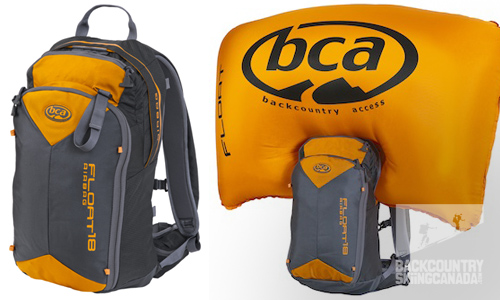
Float 30:
The BCA Float 30 (3600 grams; 8 lbs) was a logical option as many daypacks fall into the 30 litre range of storage. Interestingly, the 30 is a different beast than its bigger, newer sibling, the Float 36. The 30 has enough storage and well-thought-out features to make it an acceptable day touring pack. While some design features carry over from the 30 to the 36, the most notable differences were the back support/suspension system and the storage configuration. The 30 has a lot more back padding – almost overkill for the pack’s size – compared to the thinner, firm foam of the 36. We preferred the 36 for its snugger fit. In the compartments, the 30 has two external side sheathes for probe/shovel handle and snow saw, and one zippered main compartment with a smaller outer compartment. Both share a handy goggle/camera pouch on top of the pack. While the configuration works well enough, we prefer the 36 as it includes a zippered access point through the back (quite handy) and a roomier interior with probe/shovel pouches inside for a cleaner design. The hitch is the 36 is actually lighter (3492 grams; 7.7 lbs). It’s also worth noting each BCA pack model comes in one size only and they fit differently. The back length of the 30 is noticeably shorter than the 36, so if you have a shorter torso the 30 will be a better fit.
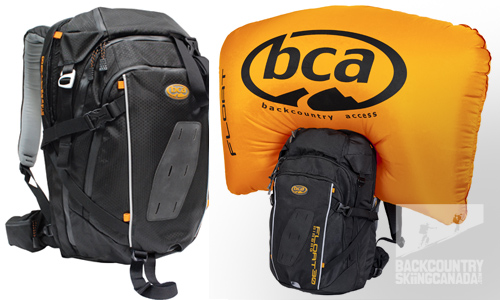
Float 36 Long-Term Review:
When it comes to an airbag backpack I think it’s best to separate the airbag from the backpack to “weigh” the pros and cons. I started using the BCA Float 36 exclusively, sacrificing lightness for safety. What doesn’t kill you makes you stronger, right? However, admittedly a month or so into touring with the Float 36 I started opting for the lighter pack on longer, more arduous trips. I still used the Float 36 on days with questionable avalanche stability, but if I was confident in the line or avalanche danger was low, I grabbed the light pack.
The goggle pouch (bottom of the image) is a handy feature of the Float 36. The main compartment zipper is next, with the zippered quick release flap for the airbag above.
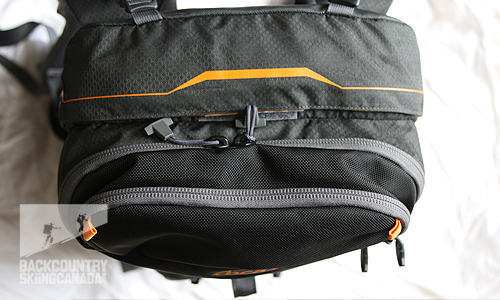
Float 36 Airbag System
While the jury was out for some time, it appears a growing body of anecdotal experiences and scientific studies are clearly showing avalanche airbags can save lives. The concept is simple: inflate a huge lighter mass that lifts above the heavy avalanche debris, keeping the person on top of the snow rather than sinking below it. Then of course there’s the added protection from trauma. As head injuries account for a significant number of avalanche fatalities, the extra padding and support has clear benefits.
BCA cites statistics gathered by the Swiss Avalanche Institute (SLF) since 1990, showing a 98 % survival rate for those who have deployed their airbags. That’s a staggering number. Especially given the average survival rate of being caught in a major avalanche is approximately 86% in North America.
The number of You Tube videos popping up also testifies to the success of an airbag backpack. Do a quick search and you find numerous examples of people who have gone for a ride and were deposited on top of metres of snow, scared, bruised but otherwise fine.
Fortunately, I did not need to deploy the airbag in an avalanche during the test period; however, I did deploy the bag (as per BCA recommendations) in a park shortly after receiving it. There is no question I feel more confident surviving an avalanche with this tool.
The airbag is activated by a small 2,700-psi (186 bar) compressed-air cylinder, which is easily refilled at an approved BCA re-filler (many scuba shops). The single-chamber, 150-liter airbag is filled via a “Venturi” system regulating the air fill rate. It takes approximately two seconds to deploy.
Unique to the 36 is a special breakaway zipper to allow the airbag to deploy (other versions use Velcro). Repacking the airbag is a bit finicky but done easily enough.
The cylinder, airflow system and bag weigh a combined 3.5 lbs (1587 grams), which is equivalent to carrying two full extra water bottles. Not a ton, but certainly enough to notice. However, this weight is packed closely to the back and around the upper shoulders (bag), which helps.
Left: The "control room" of the airbag system. Right: the trigger stores neatly into a zippered pocket on the shoulder strap to prevent unintended deployment.

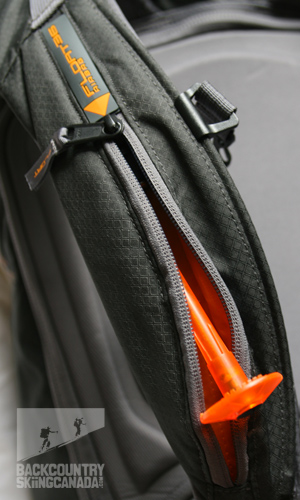
The special break away zipper ensures catch-free airbag deployment.
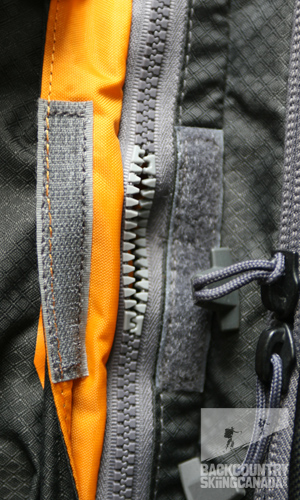
The Float 36 Backpack:
Back Country Access went back to the drawing board to design the Float 36. They say it’s “designed for avalanche professionals, guides and dedicated backcountry riders carrying their essentials.” Certainly the additional storage is welcome and plenty to accommodate all your gear plus an extra lunch and sunshine libation.
The internal frame is essentially a stiff foam back featuring additional front-pull straps that attach at the shoulder to secure the top of the pack closer to the body, and a foam-supported hip belt. Simple, comfortable and effective. My only gripe would be when I stuffed the pack full, I could feel the canister pushing through the back of the pack. With some careful repacking, this went away.
As mentioned, the back panel access opens up storage options for getting to gear quickly, and the internal shovel/probe pockets keep the pack lines clean. The vertical ski carry system works well enough, but I would have preferred a more effective offset (horizontal or parallel) system for steep boot packs.
The aluminum harness-like belt buckle was finicky at times. To fasten the buckle, you slide it through and it hooks into the other side via a flange, no clips involved. I got used to it over time and it’s important to remember the belt doubles as a sort of harness. A leg loop is tucked away under one of the two hip pockets and can be removed to wrap around the leg and fastened to the belt, assuring the pack doesn’t slide up in an avalanche. While I didn’t use this often, I can see how in the right conditions it’s a nice feature to have.
The Float 36 main compartment opens up like a clam (wider at the top and narrowed at the bottom) and is secured by heavy-duty zippers. At the top is an ample, external goggle pocket that doubled nicely as a camera case. Beneath, a convenient helmet pocket tucks under a Velcro flap for easy access (Helmets also save your life in an avalanche!). Two axe loops help secure the tools.
Inside, the Float 36 has a wide sleeve near the back and a zippered pocket, as well as the two sleeves to store the probe and shovel handle. There is no dedicated shovel blade storage, which means it was floating in the main compartment, which isn’t preferable. Otherwise, the 36 liters were plenty for packing everything required for extended day trips.
Overall, the construction quality was superb. The heavy cordura on the bottom and outside flap, and heavy ripstop nylon on the sides, was plenty, if not too durable. I could see BCA going a little lighter in the material department to shave even more precious grams off this potentially life-saving pack that is penalized mostly by its weight.
Left: the back of the Float 36 with the airbag "control room" compartment on top and the handy rear access panel below. Right: Compression strap and snowboard strap. The oversized ski carry loop fits fat skis with ease.
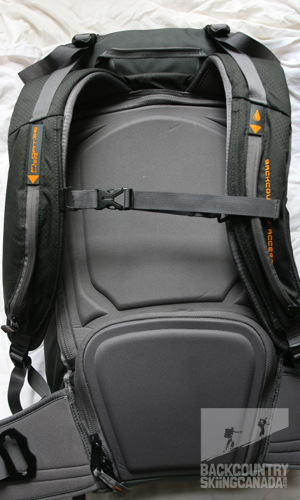


Detail of the lined goggle pocket, which doubles nicely for a camera.
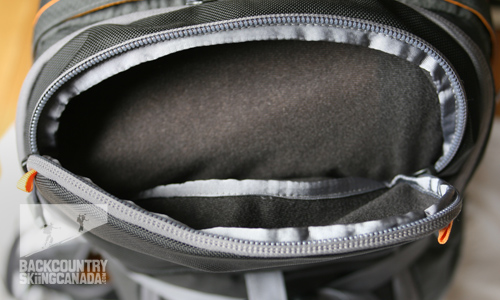
The slick external helmet pouch tucks under a flap when not in use, and secures the helmet nicely when necessary.
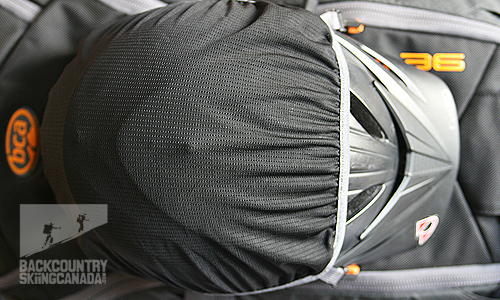
The quality reversed zippers on the Float 36 are assuredly durable.
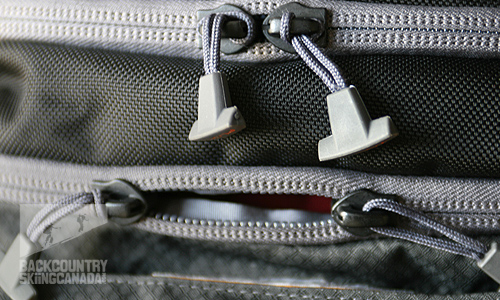
Features:
150 litre airbag, refillable air cylinder and deploy apparatus
Breakaway zipper for bag deployment
Zippered shoulder pocket for trigger handle
Suspension system
Full-length, zippered main compartment with internal probe/shovel sleeves
Two zippered internal pockets
Lined goggle pocket with external access
Two hip pockets
Tuck-away external helmet pouch
Ski/Snowboard carry system
Ice axe loops
Water bladder sleeve with insulated, zippered hose pocket on shoulder strap
Verdict:
The Back Country Access Float 36 airbag backpack is a thought-out design and works well for its intended purpose. It may be a bit overbuilt, and there are a few quirky design elements, but overall I was please with its performance and comfort.
The question remains: is the weight penalty worth the benefit? This is entirely up to the user and the style and risk of backcountry skiing they access. I was thankful to have it on some bigger descents, but found myself going for the lighter pack unless the extra protection was deemed necessary.
This in some way relates to argument that people take greater risk with a helmet. Friends, jokingly, suggested I go first to test the slope “because you have the parachute.” Did I take greater risks? I don’t think that I did. But that time I dropped in first.
Left: The Float 36 has good weight distribution with the air bag "control room" near the back and the airbag stored over the shoulders. Right: The Float 36 fits snugly to the back. We preferred the simplicity and comfort of this pack's suspension system over other models.
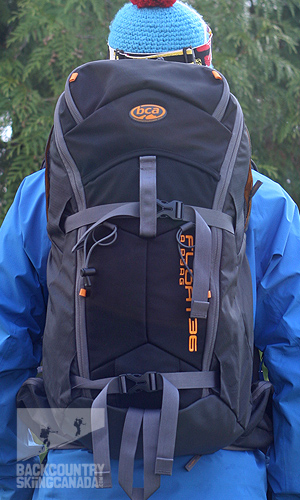

SPECS:
Price: $785
Weight: 7.7 pounds/3492 grams (system) 4.2 pounds/1905 grams (pack only)
Volume: 2197 cubic inches/36 liters
Torso lengths: one size, 17–22 inches
Colour: Black/Grey/Orange
PROS:
Airbag system works predictably
Air canisters refillable, easy for legal air transport
Comfortable suspension design
Durable construction
Handy goggle pocket that can also store 35mm camera
Internal sleeves for probe/shovel handle are handy
External rear entry
CONS:
Heavy
Finicky belt buckle system
No dedicated shovel compartment
Could have better angle ski carry system
Rating: 8/10
Comfort / Fit 2/2
Features 1.5/2
Durability 1.5/2
Function 1/2
Quality / Price 2/2
This is only our opinion. Do you disagree? Did we miss something? Are we totally out to lunch? Join the discussion in the forums here, and let us know what you think. People like/dislike gear for different reasons so chime in and we'll get a well-rounded evaluation.
Back to the rest of the reviews.
Copyright © 2023-24 Backcountry Skiing Canada. All Rights Reserved.







